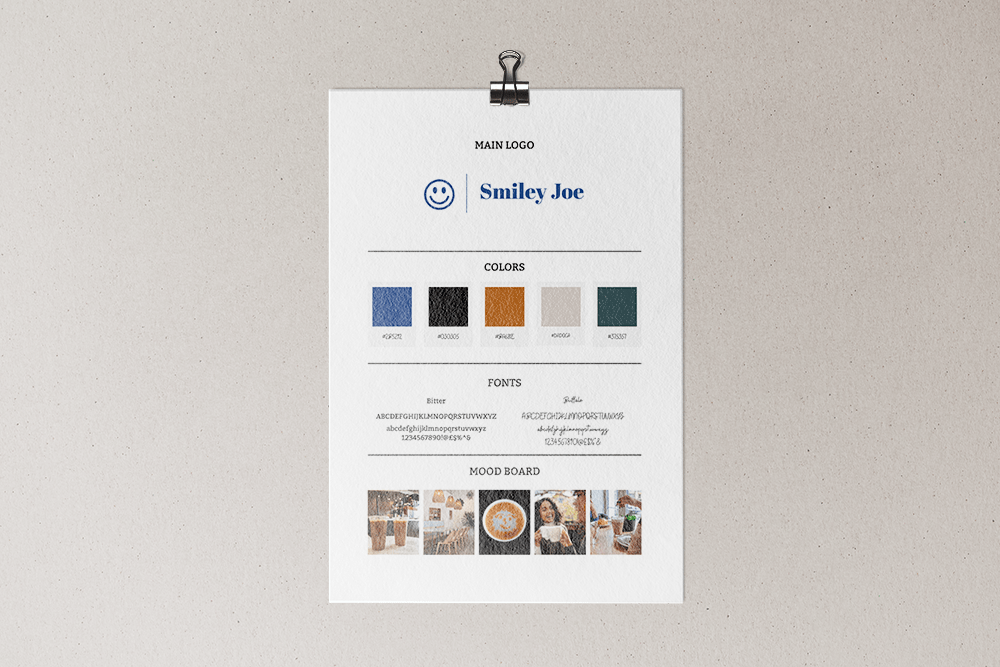How to Create a Brand Board
In this article, we will cover:
-
What branding is in graphic design
-
What a brand board is and why it is useful
-
A step-by-step guide for brand development and creating your own brand board
What is branding in graphic design? Why is it important for you?
Branding in graphic design is the use of visual elements, such as typography, color, imagery, and layout, to create a unique and consistent visual identity for a brand. This visual identity should reflect the brand's values, personality, and message, and be easily recognizable and distinguishable from competitors.
In graphic design, branding involves creating a visual style guide that outlines the specific design elements that should be used consistently across all brand touchpoints, such as packaging, websites, marketing materials, and social media. This style guide is also called a brand board. It helps ensure that the brand is presented consistently and reinforces its message and values to its audience. Brand development can take time and effort, but it's well worth it.
Here are the steps to develop your brand and create your own brand board:
1. Define your brand.
Before you can create a brand identity, you need to have a clear understanding of your brand. This means defining your brand's mission, personality, and target audience.
A brand mission statement is an action-based statement that defines the unique purpose of an organization and how they serve its customers. It acts as a guide for all of the brand's actions and decisions moving forward. It also helps to differentiate the brand from its competitors.
Examples of popular brand's mission statements are:
- Jet Blue: 'To inspire humanity- both in the air and on the ground.'
- Tesla: 'To accelerate the world's transition to sustainable energy.'
- LinkedIn: 'To connect the world's professionals to make them more productive and successful.'
- Amazon: 'To be Earth's most customer-centric company, where customers can find and discover anything they might want to buy online, and endeavors to offer its customers the lowest possible prices.'
Next, define your brand's personality. Brand archetypes are universal, psychological patterns that represent the fundamental human motivations and desires that drive consumer behavior. They are used to help brands create a compelling narrative and identity that resonates with their target audience. Determine which brand archetype your brand most aligns with:

This fun quiz can help you discover where your brand fits in best.
Lastly, create personas for your ideal customers. This exercise will help you define and visualize your target markets.

HubSpot has a great resource for creating personas easily.
2. Conduct market research.
Once you have a clear understanding of your brand, it's time to conduct market research to see what your competitors are doing and how you can differentiate yourself. Conduct thorough Google searches of other companies in your niche. Examine their branding efforts, including their logos, color schemes, and design aesthetic. Identify trends and patterns. Take note of what seems to work well and what doesn't fit. You will want to consult these notes as you move forward through the next steps.
3. Create a brand mood board.
A mood board is a visual representation of what you want your brand to feel like. It should include images and aesthetics that you want to represent your brand. This is a great way to see visualize your ultimate goal and will help you stay on track as you continue to design your brand identity.
Here is an example we made for a coffee shop called 'Smiley Joe's':

4. Develop a color scheme.
Color plays a huge role in branding and can have a big impact on how people perceive your brand. Choosing the right colors can help convey the right emotions and set the tone for your brand. Consider the emotions and feelings you want your brand to evoke, and choose a color scheme that aligns with those goals.
Looking at color psychology is helpful for this step. Our brains subconsciously associate colors with emotions.

Color Hunt and Adobe Color are two of our favorite color palette-building resources.


5. Design a logo.
Your logo is often the first thing people will see when they come across your brand, so it's important to get it right. Your logo should be simple, memorable, and reflect the essence of your brand. You could hire a professional designer, or there are several free websites available to get started. Our favorite is the free logo maker from Adobe.
With a little bit of business information,

Adobe gave me a great start that will just require a bit more customization.

6. Put it all together.
Create a 'brand board' with all of your customized visual elements. Now you will have a resource to consult prior to every design.
Conclusion.
Strong brand development takes time and effort, but it's an important investment in the success of your business. By following these steps, you can create a brand identity that truly reflects your mission and sets you apart from your competitors.
